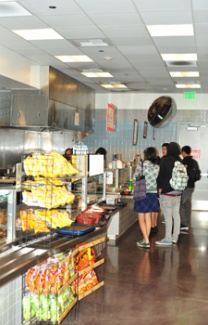
Water News
A New Law: Water In Schools
We spend a lot of time choosing a water softener or water filter to make sure our homes have clean water, but have you ever considered how important it is to have water readily available in schools?
It was recently reported that at least 40% of schools in California have no access to free drinking water for students during meals. As a result of this shocking statistic, the Governor just signed legislation SB 1413, written by State Senator Mark Leno. The California Food Policy Advocates state that this law “ensures that all California students [will] have access to free, fresh drinking water in school food service areas.”
Hydration is crucial for life and overall health. People who drink water regularly typically experience weight loss, an improvement in energy, and an increase in their ability to engage in physical activity. Extensive research shows that drinking soda and other beverages containing sweeteners increases the risk of obesity, which is growing at an alarming rate in schools throughout America.
How will schools go about providing free filtered drinking water in cafeterias to students now that they are required by law to do so?
Schools could order bottled water for their students, but this is economically and environmentally inefficient. Bottled water is extremely expensive, plus the production and delivery of the product consumes a massive amount of energy and fuel. Using bottled water in cafeterias will also create a tremendous amount of waste. The mass majority of the bottles probably wouldn’t be recycled (it’s statistically shown that 89% of empty water bottles are merely thrown away), further polluting the environment.
Here’s a good solution - install water hydration stations in cafeterias. LifeSource Water Systems offers a smaller unit that hooks up to the cafeteria’s water line. The unit filters chlorine and sediment from the water but retains healthy nutrients like calcium and magnesium. The water would then be distributed through coolers. Schools could provide students with bottles or cups so they could refill their containers throughout the lunch period at one of these water coolers. The hydration stations would work in accordance of SB 1413, plus students would receive filtered water without causing any extra pollution from plastic bottles.
These smaller hydration stations would also be ideal for school gymnasiums, practice fields, and outside in playgrounds and parking lots.
Schools could also look into water filtration systems that hook up to the main water line of the whole building. LifeSource Water Systems has commercial systems available for a number of pipe sizes, with filtration capacities up to 22 million gallons of water. Every faucet and showerhead in the school would have clean, filtered water – students could refill their bottles in the bathroom sink or in the cafeteria with healthy LifeSource water. Oxnard Community College in Oxnard, CA (pictured here) decided to take this course of action and had two whole-building LifeSource systems installed on campus so students have access to filtered drinking water wherever they go.
The fact that government officials have created legislature to ensure that students consume water during meals makes it clear that drinking water is crucial. People should have clean drinking water available everywhere, including their homes. To learn more about the importance of whole-house water filtration, visit the LifeSource Water System website.
A New Law: Water In Schools
We spend a lot of time choosing a water softener or water filter to make sure our homes have clean water, but have you ever considered how important it is to have water readily available in schools?
It was recently reported that at least 40% of schools in California have no access to free drinking water for students during meals. As a result of this shocking statistic, the Governor just signed legislation SB 1413, written by State Senator Mark Leno. The California Food Policy Advocates state that this law “ensures that all California students [will] have access to free, fresh drinking water in school food service areas.”
Hydration is crucial for life and overall health. People who drink water regularly typically experience weight loss, an improvement in energy, and an increase in their ability to engage in physical activity. Extensive research shows that drinking soda and other beverages containing sweeteners increases the risk of obesity, which is growing at an alarming rate in schools throughout America.
How will schools go about providing free filtered drinking water in cafeterias to students now that they are required by law to do so?
Schools could order bottled water for their students, but this is economically and environmentally inefficient. Bottled water is extremely expensive, plus the production and delivery of the product consumes a massive amount of energy and fuel. Using bottled water in cafeterias will also create a tremendous amount of waste. The mass majority of the bottles probably wouldn’t be recycled (it’s statistically shown that 89% of empty water bottles are merely thrown away), further polluting the environment.
Here’s a good solution - install water hydration stations in cafeterias. LifeSource Water Systems offers a smaller unit that hooks up to the cafeteria’s water line. The unit filters chlorine and sediment from the water but retains healthy nutrients like calcium and magnesium. The water would then be distributed through coolers. Schools could provide students with bottles or cups so they could refill their containers throughout the lunch period at one of these water coolers. The hydration stations would work in accordance of SB 1413, plus students would receive filtered water without causing any extra pollution from plastic bottles.
These smaller hydration stations would also be ideal for school gymnasiums, practice fields, and outside in playgrounds and parking lots.
Schools could also look into water filtration systems that hook up to the main water line of the whole building. LifeSource Water Systems has commercial systems available for a number of pipe sizes, with filtration capacities up to 22 million gallons of water. Every faucet and showerhead in the school would have clean, filtered water – students could refill their bottles in the bathroom sink or in the cafeteria with healthy LifeSource water. Oxnard Community College in Oxnard, CA (pictured here) decided to take this course of action and had two whole-building LifeSource systems installed on campus so students have access to filtered drinking water wherever they go.
The fact that government officials have created legislature to ensure that students consume water during meals makes it clear that drinking water is crucial. People should have clean drinking water available everywhere, including their homes. To learn more about the importance of whole-house water filtration, visit the LifeSource Water System website.
-
Health and Beauty
5 Benefits to Drinking Water in the Morning
-
Bottled Water
NEWS: 10X More Microplastics in Bottled Water
NEWS: 10X More Microplastics in Bottled Water
-
Water News
PFAS: The Invisible Chemicals In Your Water
PFAS: The Invisible Chemicals In Your Water
-
Health and Beauty
Beat the Heat: How to Stay Cool In a Heat Wave
Beat the Heat: How to Stay Cool In a Heat Wave
-
Water Filters
9 Red Flags: Assessing Water Filtration Systems
9 Red Flags: Assessing Water Filtration Systems
-
Home & Garden
Uncover Hidden Leaks & Save on Your Water Bill
Uncover Hidden Leaks & Save on Your Water Bill



